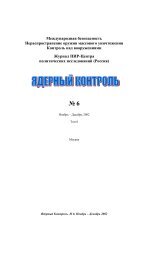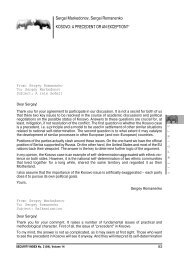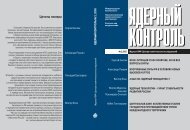Ekaterina Shadrina THE GREAT CASPIAN CAVIAR GAME
Ekaterina Shadrina THE GREAT CASPIAN CAVIAR GAME
Ekaterina Shadrina THE GREAT CASPIAN CAVIAR GAME
Create successful ePaper yourself
Turn your PDF publications into a flip-book with our unique Google optimized e-Paper software.
of recommendations for the use of standard fishing equipment, and scientific research in the field of the<br />
preservation and restocking of fish populations. Initially, only the countries of the CIS participated in the<br />
work of the committee. Iran was involved only in the capacity of an observer. In 2002, Iran became the first<br />
fully-fledged member of the committee. In line with committee recommendations, since 2001 all the<br />
Caspian countries have participated in a joint, annual program of seasonal marine expeditions to assess<br />
the number and stocks of sturgeon and to determine the impact of natural and anthropogenic factors.<br />
Each year, the committee determines quotas for fishing of sturgeon and the export of black caviar, which<br />
is subsequently submitted to the CITES Secretariat, where it is published on the organization’s official<br />
website after a review and approval process. One of the latest committee innovations is to determine quotas<br />
for a new, standardized method, involving the execution of general monitoring of fish resources in the<br />
Caspian Sea. Until now, each of the countries has presented their calculations of the size of food sources,<br />
the volume of fish in their sectors, the possibilities for restocking, the evidence used determine total fish<br />
stocks in the Caspian, total quotas for sturgeon fishing, and the distribution of these quotas between the<br />
countries. The Commission on the Aquatic Bioresources of the Caspian Sea has been functioning for 14<br />
years, and has achieved certain successes. For example, in the last two years the committee has developed<br />
and approved the Interstate Regional Program of Caspian countries for the joint management,<br />
preservation, and stable use of the bioresources of the Caspian Sea, three international seminars have<br />
been organized and conducted, cooperation has been organized between the Committee and the CITES<br />
Secretariat, and other international organizations involved in the problem of sturgeon.<br />
63<br />
The total quota for fishing of sturgeon by the Caspian states in 2006 was reduced by 23.2 percent.<br />
Source: Rakhat-TV, December 1, 2005, .<br />
64<br />
Mazhnik, Vlasenko, Khodorevskaya, et al., op. cit., p. 256.<br />
65<br />
“EU Introduces New Rules for Marking Sturgeon Caviar,” RosBiznesKonsalting, May 16, 2006,<br />
.<br />
66<br />
“New Rules to Combat Illegal Caviar Trade,” EU press release, Brussels, May 15, 2006,<br />
.<br />
67<br />
The TRAFFIC initiative was developed by the World Wildlife Fund and the World Conservation Union<br />
(IUCN) to monitor trade in vanishing species of flora and fauna, and for research aimed at the sustainable<br />
development of these species. TRAFFIC, along with the U.S. “Caviar Emptor” program created by the<br />
Pew Institute for Ocean Science, the Sea Web organization, and the U.S. National Resources Defense<br />
Council for the preservation of sturgeon are currently the leading non governmental organizations conducting<br />
information campaigns aimed at saving the sturgeon.<br />
68<br />
“Cracking Down on Illegal Caviar Trade,” WWF, July 3, 2006,<br />
A N A L Y S E S<br />
.<br />
69<br />
Jane Black, “Caviar from Farms instead of the Seas,” New York Times, September 26, 2006,<br />
.<br />
70<br />
“Black Gold: The caviar trade in Western Europe,” Factsheet, TRAFFIC,<br />
.<br />
71<br />
D. Baydeldinova, op. cit.<br />
72<br />
Vladimir Putin, speech at a meeting on the problems of the Caspian region, Astrakhan, April 25, 2002,<br />
.<br />
73<br />
Mazhnik, Vlasenko, Khodorevskaya, et al., op. cit., p. 259.<br />
74<br />
The sturgeon population in the North Caspian in 2002 was dominated by adults (80.4 percent), and by<br />
2004 their proportion fell to 61.5 percent while in the Middle and South Caspian young and sub-commercial<br />
size fish made up 88.7 and 92.9 percent of the population, respectively. Compared to 2002 figures<br />
for the shallow zone of the North Caspian, the proportion of immature fish in the sevruga population<br />
grew from 58.2 to 64.7 percent, and reached as high as 75 percent in the deep-water zone. In the Middle<br />
Caspian in general, the number of young and sub-commercial size fish increased from 55.5 to 90.0 percent,<br />
and fell in the South Caspian from 73.7 to 61.4 percent. Young fish are predominant in the beluga<br />
SECURITY INDEX No. 1 (81), Volume 13<br />
77








